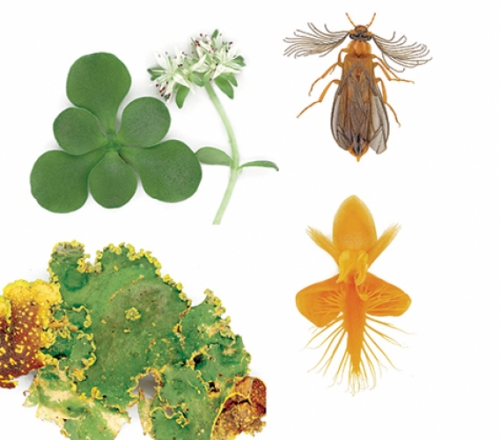Peter White tells the story this way:
On a warm, sunny day in August 1892, an amateur botanist named Albert Ruth trudged up a narrow mountain trail, surveying the forest floor. Out of the corner of his eye he noticed a stretch of small green plants. He made his way off the path to get a closer look and saw two pink flowers rising from a thin stem surrounded by round, green leaves. He got down on his knees, snipped off a sample to put in his tin box, and continued up the mountain.
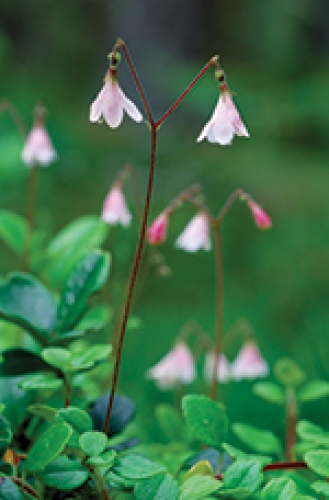
Photo by Laurie Campbell. ©2009 Endeavors magazine.

Click to read photo caption. Photo by Laurie Campbell. ©2009 Endeavors magazine.
“Everything around Ruth would’ve been exciting because his exploration was at the dawn of the age of understanding which species occur in the Smokies,” White says. “He wouldn’t have had to go very far off-trail to find interesting things.”
Back in Knoxville, Ruth mounted his finding on herbarium paper and wrote above it, “Sevier County, in mountain woods.”
Known as Linnaea borealis, or twinflower, the species had been named for Carolus Linnaeus, the father of taxonomy, who sometimes wore the flower pinned to his lapel. Twinflower is common to northern climes such as Scandinavia and Nova Scotia. It also grows in the Appalachian Mountains of New York and Pennsylvania and has been seen rarely in West Virginia. No one has ever found it in Virginia or North Carolina. Albert Ruth, who collected about fifty thousand different plants, is the only person to have found twinflower in Tennessee. Or did he?

Photo by Mark Derewicz

Click to read photo caption. Photo by Mark Derewicz
In 1981, White traced Ruth’s footsteps through the mountain woods of Sevier County, now part of the Great Smoky Mountains National Park. At the time, White was a young ecologist working for the Upland Fields Research Laboratory in Tennessee. But White found no twinflower. Over the next two decades, still searching for one rare plant, White turned up two hundred other plants never known to grow in the park. All of them are now part of the All Taxa Biodiversity Inventory (ATBI), an ongoing project that involves thousands of scientists and volunteers dedicated to preserving the park’s ecosystem. White chaired the ATBI from 2003 to 2007 and codirects the project’s science committee.
So far, ATBI scientists have found more than six thousand species that no one knew existed in the park, and nearly nine hundred more that are new to science. All told, scientists have documented nearly seventeen thousand species in the park. Nobody knows how many more are waiting to be discovered — possibly tens of thousands, White says.
The ATBI is one of the largest, most ambitious science projects in the world. No one has ever documented every living thing in such a large area, White says. The Great Smoky Mountains National Park, which turned seventy-five years old this year, spans eight hundred square miles along the Tennessee-North Carolina border. Within it are drastic elevation changes — from eight hundred to six thousand feet above sea level. The Smokies — part of the Appalachian Mountains — are very old, much older than the Rockies or Himalayas. And during the last ice age, the Smokies were not glaciated. Because of all this, the park is teeming with incredibly diverse life forms, perfect for an all-taxa inventory.
Trying to document every single species is kind of like White’s search for Linnaea — noble, fun, but extremely difficult. Would scientists look under every rock and inside every cave throughout such a big chunk of land, much of which is tough to traverse? Could they find every species of fungi or bacteria, or the rarest of moths? Could White finally find Linnaea borealis?
The idea of finding every single species in a conservancy or national park had been floated before — in Costa Rica, for instance, where it never got off the ground. Keith Langdon, a biologist with the Great Smoky Mountains National Park, heard about the Costa Rican plan and thought that his park should do an all-taxa inventory. After all, the park has a congressional mandate to preserve everything within its borders. How can you protect and preserve what you don’t know is there?
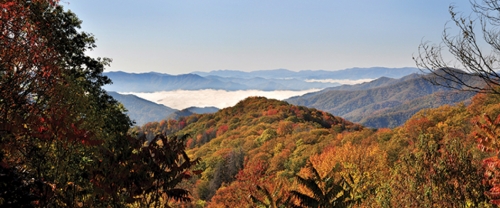
Photo by Jeff Davis. ©2009 Endeavors magazine.
The scene of the quest. Is it possible to find every species in the most biologically diverse national park in the United States? Scientists and volunteers from around the country have been scouring the Great Smoky Mountains National Park to find out.

Click to read photo caption. Photo by Jeff Davis. ©2009 Endeavors magazine.
Langdon had already been helping hundreds of scientists each year organize research trips to the park. He thought he could coordinate them for an all-taxa inventory. Langdon called White, who had published the most recent checklist of wildflowers in the park. (See Endeavors, Fall 1998, “Wild as the Hills.”)
“I had set up permanent vegetation-monitoring plots where you take a chunk of forest and map every tree and go back every five years to see how much the forest is changing,” White says. “So Keith and I were buddies already.”
Langdon invited 120 scientists, all of whom showed up for a meeting in Gatlinburg, Tennessee. “This showed the incredible enthusiasm that was out there for doing something grand, something Don Quixote-like,” White says.
To their astonishment, the ATBI attracted more than one thousand scientists and college students from across the country, as well as eight hundred educators, students, and interested citizens. Hundreds of other scientists from twenty countries also participated, some volunteering time to compare newly found species in the park to specimens in museums around the world.
But even with thousands of volunteers it would take centuries to look for every bit of life in every square foot of the park.
So White, in charge of creating the ATBI science plan, separated the search for species into two major categories — structured sampling and traditional, unstructured observation. The latter is what happens when scientists and volunteers wander through the landscape looking for new species. They use intuition and instinct to determine if a particular habitat is worth their time and effort. If they find nothing new, they walk faster, White says. If they find something interesting, they walk slower. This takes a lot of patience and time, especially when trying to find elusive creatures such as spiders, salamanders, or sluggish caterpillars and their adult forms, butterflies and moths.
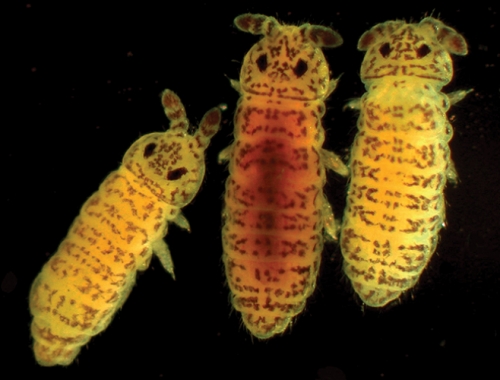
Photo courtesy of Discover Life in America. ©2009 Endeavors magazine.
Scientists named the Lamar Alexander springtail after the Tennessee senator in appreciation of his support for research funding.

Click to read photo caption. Photo courtesy of Discover Life in America. ©2009 Endeavors magazine.
Back in his day, Russian novelist Vladimir Nabokov spent years in pursuit of butterflies. He’d spot an interesting one floating through a meadow, wait for it to settle on a flower, and then swoop it up in a net. The butterfly might’ve looked similar to another one he had already caught. But there might have been, say, red dots on both wings, possibly signifying a new species. Nabokov would take it back to his house, check the literature on butterflies with red dots, compare his specimen with others from museum collections, and — if he was really serious — submit his discovery to peer-reviewed journals.
Unstructured sampling is the most efficient way to quickly inventory a habitat, and with a little training just about anyone can do it. But the method isn’t sufficient for an all-taxa inventory. You miss too much when you sweep through an interesting landscape in a single pass. So White’s science plan includes structured, year-round sampling.
Twenty scientists were assigned to lead taxonomic working groups, or TWIGS, in their fields of expertise. There’s the slime-molds TWIG, the reptiles TWIG, the fungi TWIG, the plants TWIG, and so on. The plan also includes special teams, such as the tree climbers from Central Missouri University, charged with finding fungi, snails, and whatever else lives atop the tallest, oldest trees in the Smokies.
TWIG leaders set twenty plots that vary by elevation, vegetation, topography, geology, human activity, and other environmental and biological factors. Sometimes researchers set up standardized traps for various lengths of time to catch different species of bugs or bees, for instance. Over time, different species accumulate in the traps, allowing scientists to estimate how many species are in a particular area. Or scientists simply go to these plots throughout the year to see what they can find.
Because the twenty plots are representative of the whole park, scientists can estimate how many species might exist across the entire eight-hundred-square-mile span. But there’s a lot of stuff you can’t find with traps and observation, and enormous reaches of the park remain unsampled. White estimates that forty thousand to two hundred thousand species inhabit the park.
Had Nabokov still been around to take part in the ATBI’s structured sampling, he would’ve been assigned to the lepidoptera TWIG led by Dave Wagner, an ecologist at the University of Connecticut.
Wagner’s quest for life falls somewhere between traditional observation and structured sampling. “We descended onto the park en masse, hit it as hard as we could, and then got out of town,” Wagner says. “It was like a paramilitary operation, and we ran it like one.”
Over the course of one weekend, Wagner worked with eighteen of the top taxonomic authorities in the world, twelve graduate students, and twenty or so volunteers.
They searched for butterflies and set forty traps at different elevations and in every kind of habitat they could think of. “We sent a team up a mountain with llamas that carried our traps and batteries so that we could sample the grassy balds at higher elevations,” he says. “At night we used lights to attract moths to white sheets. We looked under leaves for tiny moths. We set baits — brown sugar and beer, the more fermented the better. That stuff can attract moths from hundreds of yards away.”
Wagner led these bioblitzes four times between 2000 and 2006. Each time, his group processed about forty thousand specimens. Often they targeted habitats where they thought particular moths might live.
This is how they found a moth that an expert from the Smithsonian Institution recognized in the field as a species new to science.
“It’s black and white and perches on the upper side of leaves,” Wagner says. “Essentially, it mimics a splat of bird poop. That’s its gimmick.”
During these blitzes, Wagner’s team held sorting and identification workshops so that all the species could be tallied and cataloged.
Before the ATBI, there were 891 butterfly and moth species known to flutter through the park. Wagner’s group found 944 species new to the park and 36 species new to science. Only one other TWIG outdid Wagner’s group — the beetles TWIG. Prior to the inventory, scientists had documented 887 beetle species in the Smokies. During the inventory, they found 1,448 species new to the park and 42 new to science.
And then there’s the really tiny stuff, such as tardigrades and bacteria. Tardigrades are microscopic creatures also known as water bears because they live in moist areas and resemble pudgy bears. Before the ATBI, scientists knew there were three species of tardigrades in the park. During the inventory, they found fifty-six species new to the park and eighteen new to science. (See related story: “Tardi-whats?”)
As for bacteria, no one had ever documented which species were in the park before ATBI scientists found 479 (270 of which are new to science). Finding new bacteria might not seem as interesting as watching a weird-looking caterpillar turn into a previously unknown species of butterfly, but the results could be more important, White says. In the hot springs of Yellowstone National Park, scientists found a bacterium now used in DNA testing and other molecular applications. They also found a bacterium that might help improve the production of biofuels. There aren’t any hot springs in the Great Smoky Mountains National Park, but the hundreds of previously unrecorded bacteria found during the ATBI no doubt have some purpose in the park’s ecosystem.
ATBI scientists also found sixteen different viruses, eleven of which are new to science and five — including West Nile virus — that are new to the park. Scientists are now studying the rare virus’s distribution in the park.
Some species found during the ATBI, such as the Chinese jumping worm, are invasive. Ecologists were surprised to find the worm, which devours the upper layers of earth that are necessary for soil to recycle nutrients and retain moisture. “Fishermen probably bought the worms at local bait shops and then released them,” White says. Luckily, ATBI scientists found the worm before the species became widespread.
White also says that the ATBI could find helpful species.
In the early twentieth century, uncontrolled logging in the Southern Appalachians led to severe soil erosion. White says that the Smokies might be home to organisms that could help replenish the eroded landscapes. “Some of the smallest critters are the lungs and power plants or the digestive system of the ecosystem,” White says. But we don’t really know how all the species interact as part of this scheme.
The inventory also has an educational benefit. Teachers have taken hundreds of students to the Smokies to help find species. In 2004 high school students from Cherokee, North Carolina, searched for soil invertebrates for the ATBI. They found a bunch of tiny, wingless soil insects called springtails and sent fifty specimens to University of Tennessee professor Ernie Bernard, head of the nematode TWIG. He noted that the tiny creatures had a purple tint and white rings around their antennae. He suspected that the students might have found a new species, but when he and graduate student Kelly Felderhoff went back to the Smokies to verify the finding, they found no springtails. Several times over the course of three years, Felderhoff returned to the original site with no luck.
In February 2008 Susan Sachs of the Appalachian Highlands Science Learning Center took another class of students from Cherokee back to the Smokies. After digging in the dirt for an hour, the students came up with a few possible matches. Back at her lab, peering through a microscope, Felderhoff determined that the students had unearthed a springtail species called Pogonognathellus nigritus. In 1951 a researcher had discovered this species in New York. But it was never found again, so the species name had been invalidated. Thanks to the students, the ATBI has verified the existence of Pogonognathellus nigritus, which has a much wider range than anyone had thought.
While planning for his trip to the Smokies in 2006, White pored over old U.S. Geological Survey maps at UNC’s Wilson Library. He found one from 1893 that showed the only three trails that Albert Ruth could have used to penetrate the higher elevations of Sevier County at Newfound Gap, Indian Gap, and along Porter’s Creek.
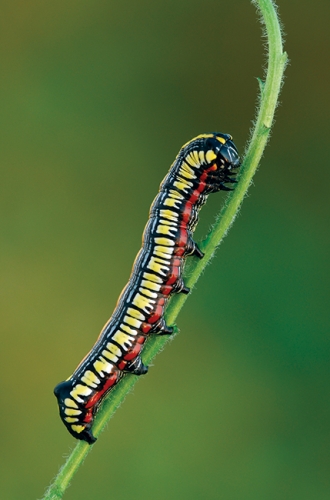
Photo by Mike Thomas. ©2009 Endeavors magazine.
The Cucullia convexipennis caterpillar, found during a bioblitz, has not been found any farther south than the Great Smoky Mountains.

Click to read photo caption. Photo by Mike Thomas. ©2009 Endeavors magazine.
White took notes and headed to the Smokies with grad student Julie Tuttle and seven others. They parked at the visitor’s center, hiked four miles into the wild, and set up camp. The twinflower search was on.
“We kind of zigzagged back and forth on the slope, hoping to run into it,” White says. “Sometimes I thought we were searching for a needle in the haystack and we’d never find it, and sometimes I thought it was right around the next bend.”
On day one the group hiked up the steep north-facing slopes that are between four thousand and five thousand feet above sea level. White told his volunteers to call him on his cell phone if they saw clumps of green leafy plants scattered along the forest floor. A few hours later, they came across a patch of plants with fuzzy flowers. To the nonexpert, it looked like twinflower — small, pretty and pink, surrounded by delicate green leaves. White looked it over and knew it was not Linnaea. It was Oxalis montana. They took a sample for the ATBI. As the search continued, White told everyone to look for paper birches. Discovered in the park in the 1970s, just a few dozen of the trees grow there. White knew that Linnaea likes to cozy up to paper birches. Carefully hiking down the steep mountainside, White’s crew came upon a long, narrow clearing strewn with rocks, rubble, and downed trees. Some time ago, an avalanche there crushed everything in a path twenty meters wide.
“There are a huge number of landslides in this area,” White says. “The only population of Linnaea could’ve been taken out, for all we know.”
Later on they spotted Clintonia borealis, which grows in the same cold, moist evergreen forests as Linnaea. They documented nineteen species of plants and one animal species — a snail that quickly retreated inside its shell and started spinning on its side when picked up. The next day they found ten more plant species, but not Linnaea. They marked their locations on maps using GPS so White could keep track of where his search had taken him.
In 2008 White used those maps for another search with three more volunteers. On July 19 White’s group left the Appalachian Trail and headed down a rugged north-facing slope. Three hundred meters off-trail, they spotted a cluster of eight paper birches. They scrambled to the base of each tree and searched the surrounding area. Again, no Linnaea. But those trees wound up being the most southern population of paper birches in North America, another ATBI discovery.
White’s maps are now speckled with red and purple dots that represent where he’s searched for Linnaea as part of the ATBI’s vascular plant TWIG. His search is mostly traditional observation but is getting more structured thanks to maps that his former graduate student Todd Jobe produced.
For his dissertation, Jobe wanted to figure out how easy or difficult it would be to walk to different parts of the park. He thought this would help TWIG leaders plan more efficient sampling trips. He researched human physiology and energy expenditure to calculate how accessible any part of the park is from any trailhead. He used published models of humans walking on treadmills and added into his equations various simulations of people hiking through vegetation, across streams, and up and down steep slopes. The maps show vast areas of the park that are tough to get to, and give researchers a good idea of how long it would take to explore these areas and how physically taxing such trips would be.
Jobe and fellow grad student Jason Fridley also made models showing the bias of unstructured specimen sampling. They collected data on where flora sampling had been done in the park between 1974 and 2003. As they suspected, most scientists had sampled near easily accessible trails. Could sampling near paths capture the true diversity of the park?
“In general, the sampling had captured the major vegetative communities, such as spruce-fir forests,” Jobe says. “But within a spruce-fir zone there are big patches that were not sampled. We might be missing things about some of those communities.” Spruces grow high up mountain slopes, and a lot of that land is not easily accessible.
Jobe used his maps to pinpoint the most inaccessible places in the park, and then hiked to them. In one case, he looked for a particular outcrop of igneous rock, figuring that this landscape might reveal something different from areas with no outcrops. He found the spot. The view was unbelievable. But he says, “We saw nothing different there.”
Smiling, he adds, “No Linnaea.”
In his Chapel Hill office, White wheels his chair around to his computer to show me one of Jobe’s maps of the Great Smoky Mountains National Park.
“These brown areas are where we’ve been searching for Linnaea,” he says. “But there’s a mountain that’s even more remote than where we’ve been. And if we don’t find it in these valleys, then I want to go there, to Mount Guyot, because that’s really hard to get to. Very few biologists have been to the top of that mountain for any length of time.”
In the summer of 2009, White will drive to the Smokies, park at the visitor’s center, and spend the night at a shelter in the woods of North Carolina. Then he’ll hike to Newfound Gap and search a few north-facing slopes and the valleys where Porter’s creek is nestled.
He’ll look for pretty pink twinflower. He doubts he’ll find any; he knows the odds are against him. But he can’t stay away. Chances are he’ll find something no one knew was there.
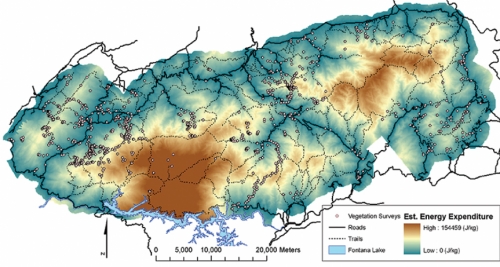
©2009 Endeavors magazine.
Todd Jobe, a postdoctoral fellow in UNC’s geography department, produced this map to show where scientists had conducted sampling in the park. Many of the highest and least accessible elevations (in yellow and orange) have not yet been sampled.

Click to read photo caption. ©2009 Endeavors magazine.
Still, White is somewhat vexed that he hasn’t been able to find what Albert Ruth stumbled upon. It’s made him wonder if Ruth actually found twinflower in the first place. It doesn’t help that Ruth misidentified the plant as Mitchella repens.
When Ruth retired to Texas he took his personal collection with him but left thousands of specimens at the University of Tennessee herbarium. In 1934 the herbarium burned to the ground, forcing botanists back into the field to refind tens of thousands of plants. They wrote letters to universities across the country — including UNC, which has the largest herbarium in the South — asking for help in replenishing the university’s collection. A thirty-year-old botanist named Jack Sharp wrote to Albert Ruth’s daughter Gertrude to see if she was willing to send her father’s collection to Knoxville. She was. And Sharp pored over thousands of pressed plants until he came across a curious label that read, “Mitchella repens, Sevier County, in mountain woods.” But Sharp noticed that the plant was clearly Linnaea. So he relabeled it.
White has seen the original specimen. It’s Linnaea borealis. In Ruth’s own writing, the label reads, “Sevier County.” He could’ve forgotten that he had traded plants with a botanist from the north, White says. Or maybe Ruth got confused and labeled the specimen incorrectly years after he thought he had found it in the Smokies. But White says it’s more likely that Ruth compared his specimen to the literature and saw that Mitchella repens, which does strike a close resemblance to Linnaea, is common in the eastern United States.
“I think Ruth found Linnaea,” White says. “But it could just not be growing there anymore. I happen to think it’s still there and I have a checklist of places I’d like to go and look. Now, maybe it’s like the paper birch. Maybe we’ll find a different population than the one Ruth found.”
The ATBI still considers Linnaea a species of the park, but with one qualification: “Linnaea borealis: not seen in over one hundred years; go forth and hunt for it.”

